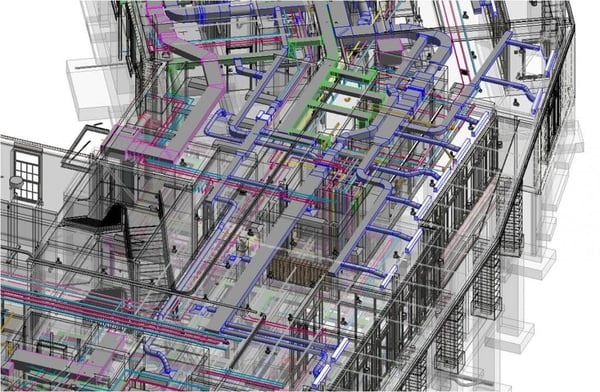In the sheet metal industry, especially for construction, innovation and technology drive progress. Among the many advancements in recent years, Building Information Modeling (BIM) has emerged as a transformative tool, reshaping the way various construction processes are executed. BIM is not merely a digital representation of a building; it's a dynamic process that integrates various aspects of construction, from planning and design to implementation and operation. When it comes to HVAC fabrication, BIM offers a variety of benefits that redefine how HVAC systems are designed, produced, and installed.
The Value of BIM for the HVAC Sector
Enhanced Collaboration: Traditionally, HVAC construction involved several stakeholders, including architects, engineers, contractors, and subcontractors. The interdisciplinary nature of BIM fosters seamless collaboration among these parties by enabling real-time data sharing. This collaboration streamlines decision-making processes and minimizes discrepancies, reducing the likelihood of errors before and during construction.
Accurate Spatial Visualization and Clash Detection: HVAC systems are intricately woven throughout a building's design. BIM software provides a comprehensive 3D model that showcases the integration of HVAC components within the entire structure. This spatial visualization not only helps identify clashes with other systems like electrical and plumbing in advance but also allows for better coordination between structural and HVAC designs. This early detection minimizes rework, prevents costly delays, and ensures that all systems are in accordance.
Efficient Energy Management: HVAC systems play a critical role in a building's energy consumption. BIM allows for simulations and analysis of different HVAC design scenarios, aiding in the selection of energy-efficient options. This proactive approach aligns with sustainable construction practices and helps reduce a building's operational carbon footprint.
Precise Cost Estimation: Budget overruns are a common concern in construction projects. BIM provides accurate material quantities directly from the digital model, allowing for more precise cost estimation. This information helps with effective budget planning and management, ensuring that the HVAC project stays within financial limits.
Optimized Maintenance and Operations: The advantages of BIM extend beyond construction completion. The data-rich model created during the design and construction phases can be handed over to facility managers for ongoing maintenance. Access to detailed information about HVAC components makes maintenance scheduling more efficient and reduces downtime during repairs. The comprehensive digital model also aids in future renovations and expansions, making modifications less complex and more informed.
Risk Mitigation: Construction projects inherently involve risks, and HVAC systems are no exception. BIM's ability to simulate various scenarios enables contractors to identify potential risks and develop contingency plans before they become problems. This proactive approach safeguards the project timeline and reduces unforeseen challenges.
Integrating BIM into Your HVAC Duct and Fittings Fabrication Business
In HVAC duct and fittings fabrication, embracing BIM technology can be the differentiating factor between mediocre and exceptional outcomes. The integration of BIM into sheet metal fabrication processes revolutionizes how projects are planned, executed, and maintained, ultimately yielding benefits that reach across the lifecycle of a building. As the construction industry continues to evolve, BIM's importance in HVAC will continue to grow. It empowers contractors to surpass the capabilities of traditional methods and embrace a future where efficiency and collaboration are at the forefront of every project.

